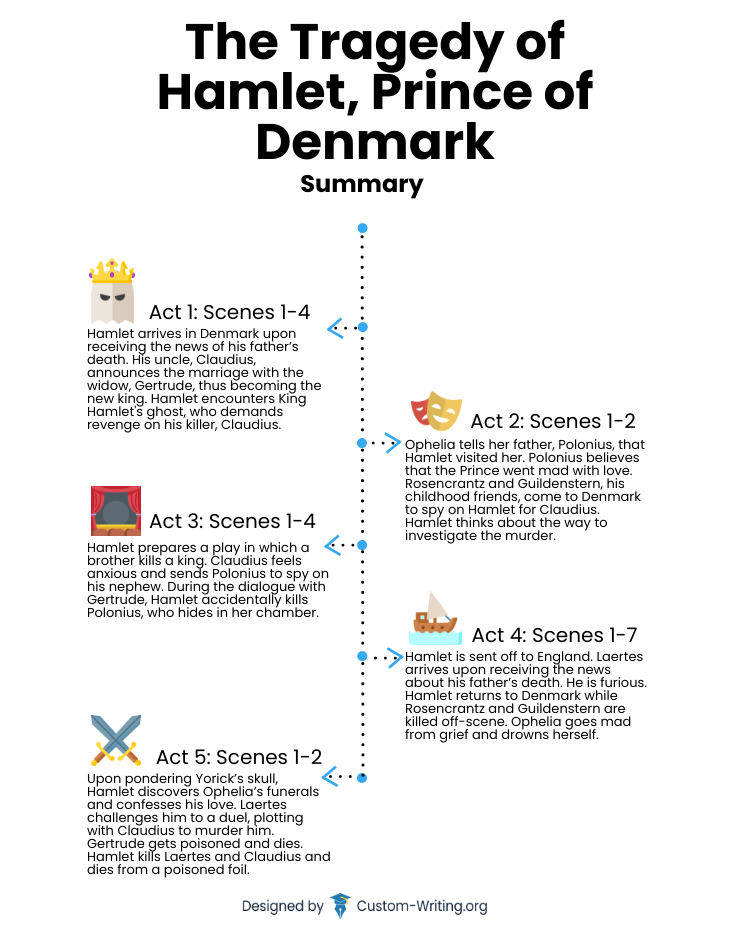Welcome to Hamlet summary and analysis page! Here is a short synopsis that covers all the key events in the play’s plot:
Hamlet, the Prince of Denmark, is devastated by his father’s death and his mother’s hasty remarriage to his uncle Claudius, who has taken the throne. He is further shaken when his father’s ghost appears, revealing that Claudius is his murderer. Hamlet seeks justice but hesitates to act directly, taking a slow, strategic approach. His quest ends in a deadly duel where he, Laertes, Gertrude, and Claudius all die. In the aftermath, Denmark descends into chaos, and Prince Fortinbras of Norway arrives to restore order.
In this guide by Custom-Writing.org experts, you’ll find Hamlet short summary and analysis act by act. Let’s dive into the intricacies of Shakespeare’s most famous play!

How many acts in Hamlet?
Traditionally, the play is divided into five acts. It is interesting to note that earlier texts of Hamlet were arranged differently. There was no actual division between acts and scenes. This division of the play came only in 1976.
What is Hamlet about?
If you were to write Hamlet’s short summary, it should include the following details. It is a story about Hamlet, whose mother married the man responsible for the death of his father, which makes Hamlet resentful and searching for revenge.
Hamlet Act 1: Summary & Analysis
The beginning of the play is marked with a feeling of anxiety. There are several causes for it.
- The first one is the ghost that has been witnessed by Barnardo, Horatio, and Marcellus. Most people during Shakespeare’s times believed in evil spirits.
- The second cause of nervousness is the death of Old Hamlet. A Norwegian prince Fortinbras wants his lands back. Barnardo, Horatio, and Marcellus talk about this when they see the ghost for the second time. The ghost looks like a deceased King.
Horatio tries to talk to the ghost, but it disappears without speaking. In Shakespeare’s times, there was a common belief that spirits could only speak to the person the message was sent. Shortly after the ghost leaves, Horatio, Hamlet’s only friend in the play tells Hamlet what happened. This opening scene is crucial for the understanding of the piece. It not only tells about the state of affairs in Denmark but also prepares the audience for one of the most critical episodes—an encounter between the ghost and the young Hamlet.
It is also worth mentioning the way the play starts. It starts with the question, “Who’s there?” This question becomes the rhetorical question of the whole piece. Who is Hamlet? What moves him? What stops him from acting? In the past several centuries, these questions have been answered by many critics. Some of them believed it was melancholy; some thought it was fear. Some attributed an Oedipus complex to him. However, all of them agree that Hamlet’s plot is multilayered, and its structure is peculiar.
If the first scene started almost in the darkness, the second one is in vivid contrast. The audience sees a bright and colorful setting. Claudius, Hamlet’s uncle and new stepfather, gives long speeches in which he expresses sadness for his brother’s death and his happiness about his new marriage. Hamlet is dissatisfied with it; he says, “But I have that within that passes show, / These but the trappings and the suits of woe.” He is grieving his father and is upset about his mother’s prompt marriage.
Claudius and Gertrude, Hamlet’s mother, think that this type of grief is unnatural. Shortly after, they exit the scene, and Prince is left alone. At this moment, Hamlet speaks his first soliloquy that starts with, “O that this too, too sullied flesh would melt…” He shows disgust to his mother for marrying her husband’s brother, “Frailty, thy name is a woman!”
The audience understands that there is a lot of tension in the play. Therefore, it is vital to underline three conflicts:
- The first one is in the kingdom.
- The second one is in Hamlet’s family.
- The third one is in Hamlet’s mind.
Hamlet’s speech is over, and his friends enter. Horatio, Marcellus, and Bernardo come to the stage. They tell Hamlet that they saw a ghost of old Hamlet. Hamlet says, “though hell itself should gape / And bid me hold my peace.”
Polonius appears along with his kids; their family seems ordinary. He is concerned with the well-being of his son, Laertes. However, at the same time, Polonius seems very insincere and polished in his speeches. He uses a lot of proverbs and cliches. He also suggests that Laertes should, “This above all, to thine owne selfe be true,” which is very confusing. In the next scene, the readers see Polonius asking Reynaldo to spy on his son. This completely undermines the moralistic tone in which he was teaching his kids.
Polonius’ daughter, Ophelia, is also introduced. Whenever she has a chance to speak, the audience sees her intelligence and emotionality. However, most of the time, she remains silent.
Polonius’s family is juxtaposed with Hamlet’s one. The ties in Hamlet’s family are completely broken. His father is dead; his mother married the man who is responsible for the death of old Hamlet, Prince is dissatisfied with that.
In the next scene, Hamlet sees the ghost of his father. He asks Hamlet to come forward, while Horatio tries to hold him because he is worried about his friend. In this scene, Marcellus says one of the most famous lines in the entire play, “Something is rotten in the state of Denmark.” This line can be seen as the play’s exposition.
The audience sees the dialogue between the ghost and Hamlet only in the next scene. The spirit explains that he is Hamlet’s father, and he has been killed. He also tells Hamlet to seek revenge. Then, the ghost tells who it was. He says that his brother Claudius poured poison into the king’s ear while he was sleeping. Hamlet, who was already suspicious of his uncle, is shocked. The ghost also tells Hamlet not to seek revenge against his mother.
After this encounter, Hamlet tells his friends to “Swear!” He asks them to swear to a secret plan. The rising action in Hamlet’s plot starts from now on.
Hamlet Act 2: Summary & Analysis
The second act opens with Polonius instructing Reynaldo to spy on Laertes, who studies in Paris. Polonius is a character that loves to spy on others. This type of behavior will eventually lead to his death. In the same scene, the audience sees how Ophelia and Hamlet interact with one another. The crack between two young lovers starts to grow. However, the audience does not understand the real reason behind it.
All of the characters, including Ophelia, Gertrude, and Hamlet’s friends Rosencrantz and Guildenstern, notice significant changes in Hamlet’s behavior. Gertrude urges the friends to visit her “too much-changed son.”
Polonius offers his version of why Hamlet’s behavior changed. He thinks that it is because of his love for Ophelia.
Hamlet Act 3: Summary & Analysis
Hamlet over sudden questions Ophelia’s chastity. He contradicts himself, saying that he once loved her and refusing it immediately after. Ophelia does not say much. She simply states, “I was the more deceived.” Hamlet is offended and tells Ophelia to “Go thy ways to a nunnery.” It could mean go to a monastery or go to a whore house.
The tension between Hamlet and Gertrude keeps growing. Claudius suggests sending Hamlet to England. Also, the readers learn that Claudius does not trust Gertrude. So, he sends Polonius to spy on her while she is talking to Hamlet. The end of Act 3, Scene 3, is one of the culmination of the play as Claudius admits his guilt at the end of the scene.
In the next scene, the audience sees the most emotional moment in the entire play. Hamlet and Gertrude exchange accusations for disrespecting Old Hamlet’s memory. Hamlet urges his mother to understand that marrying Claudius was wrong. He contrasts his father with Claudius and even talks about sexual relationships between his mother and his uncle. Many critics read it through the prism of Freud and believe that Hamlet was suffering from the Oedipus complex. In the same scene, Hamlet accidentally kills Polonius, who was spying on them. This is Hamlet’s climax.
Hamlet Act 4: Summary & Analysis
Gertrude tells Claudius that Hamlet murdered Polonius due to his madness. Hamlet feels no remorse for doing so, even when he’s sent off to England as a result.
Ophelia is very upset about that. Not only she lost the love of her love, but Hamlet also murdered her father. Laertes is furious too, and he says, “To hell allegiance, vows to the blackest devil, / Conscience and grace to the profoundest pit! I dare damnation.” He sounds like someone ready for revenge.
By the end of Act 4, Hamlet returns to Denmark, and Gertrude announces sad news to everyone: Ophelia drowned. This episode is the falling action of the play.
Hamlet Act 5: Summary & Analysis
The final act of Hamlet starts as a comedy in which two gravediggers prepare a grave for Ophelia’s funeral. Hamlet, at the same time, thinks about the universality of death.
Prince finds a skull of his father’s jester, that passed away many years before. Hamlet picks it up and exclaims, “Alas, poor Yorick! I knew him, Horatio, a fellow of most infinite jest, most excellent fancy.” The images of the jester alive bring chills to the audience. Hamlet continues wondering that even the most prominent rulers and people did not escape the sentence of death. All of us will die one day.
Once Hamlet sees Ophelia’s funeral, he finally realizes that she is dead. Laertes is killed with sorrow and pain, as he jumps into her grave. This pains Hamlet, who leaps into the pit as well and starts fighting with Laertes. He states that he loved Ophelia more than anyone else.
Later in the Act, Hamlet offers apologies to Laertes. Despite accepting them, he invites Hamlet for a duel thanks to Claudius, who strives to get rid of his nephew. He poisons Laertes’ sword and the drink that later offers to Hamlet.
During the duel, Laertes wounds Hamlet, who deadly injures him in return. Both of them are about to die. At the same time, the Queen falls on the floor as she drank from the poisoned cup.
The impending death liberates Hamlet, and he is finally ready to act. He wounds Claudius with a poisonous blade.
Hamlet forgives Laertes, who begs for forgiveness. Seeing his friend’s upcoming death, Horatio is willing to follow Hamlet into the abyss, but the prince discourages him from the suicide. Hamlet’s last words are very memorable, “The rest is silence.” This is the resolution of the play.
Fortinbras, the Norwegian king, who attacked Denmark, finds the bloodbath that happened seconds before his return. Only Horatio can retell the story of what was going on in the kingdom.
Thanks for reading the play’s summary and analysis! For more information, check other articles about Hamlet. To write a flawless essay on the play, see our topics and samples.


![Hamlet Themes: Death, Revenge, & Others [With Quotes]](https://custom-writing.org/blog/wp-content/uploads/2021/02/Themes-284x153.jpg)








